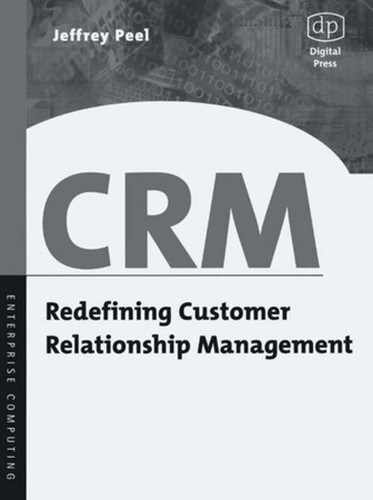
54 4.3 The portal concept
4.2
4.3
Later in the book I discuss the marketing aspects of CRM. However, it is
worth stating here that integration technologies will allow greater closed-loop
systems to be developed, enabling customers and vendors to see the conse-
quences of each other's actions much more clearly. The relationship becomes
more open and transparent, and each party can then define more precisely the
nature of the relationship that they require.
Such systems, are, therefore, intimately linked to brand management
processes, because brands succeed or fail on the basis of how well they engage
customers for a long-term profitable relationship. If CRM applications are
disjointed and uncommunicative, it is quite possible that a customer could
have a whole series of uncoordinated and inconsistent brand experiences that
reduce loyalty or make continued loyalty difficult to predict.
Myriad definitions
Chapter 9 introduces the concept of dynamic e-processes and presents a view
from a Hewlett-Packard position paper that such processes represent the third
phase of an evolution toward intercompany application integration. In my
view they are merely a subset of the various integration processes companies
will need to have in place to create a consistent and unified customer
experience.
Even today, we are faced with an array of technologies that are at the same
time exciting, confusing, and overlapping. Vendors do not make the situation
any easier by using sloppy language and attempting to force-fit their offerings
into categories into which they were never designed to fit.
Why are these technologies of interest to us? Well, they are of interest
because they help get relevant information or services to where they need to
go, thereby enriching the customer experience. Brand engagement comes
about when vendors proactively add value to the relationship in various ways.
Should a customer spontaneously make contact via a storefront or via the tele-
phone there is a requirement for the quality of service to be high and for key
transactional information to be provided. The technologies that make this
possible, increasingly, are integration technologies.
The portal concept
Application integration is of use only if there is a common access point or
interface into these integrated applications. Numerous vendors are competing
for this space, including an array of enterprise portal players (i.e., software

4.3 The portal concept 55
m
m
vendors that offer integration technologies or browser-based front ends on
disparate corporate data resources).
However, several of these portal players are also actively developing offer-
ings to allow emerging standards to play a part in the process. This is where
things get a little complicated. The logic is that if the first phase in the devel-
opment of e-processes is getting information to where it needs to go within the
corporation, it makes sense to adopt technologies that will allow the corpora-
tion to engage in external transactions as well without having to rip out all the
plumbing. Therefore, a blurring of category boundaries occurs between appli-
cation integration technologies, portals, and Web services.
Web services is an emerging concept, one not wholly described as yet by
international standards, that allows seamless connectivity between disparate
applications that may be of use to an organization hoping to define an
e-process (made up of a bunch of Web services). Not exactly a purist defini-
tion, but it'll do for the minute. Here's a more exacting one from Adam
Bosworth of Crossgain Corporation: 1
The term "Web service" describes specific functionality, value deliv-
ered via Internet protocols, for the purpose of providing a mechanism
for another service or application to use.
Web services enable the componentization and reuse of traditional
Web applications. And example is a Web service to calculate sales tax.
As a Web service, applications have the ability to embed the sales
tax functions, or Web services, to create an online consumer sales
experience.
By exposing components of applications as Web services, and ena-
bling businesses to invoke these components, businesses can fun-
damentally transform their ability to interact and engage with both
current as well as potential customers and partners. Web Services
will fundamentally transform Web-based applications by enabling
them to participate more broadly as an integrated component to an
e-business solution.
However, a point about Web services needs to be made. There are many
analysts and software firms arguing that Web services will essentially replace
all internal systems and processes. This is utter nonsense. In the same way that
Application Source Providers (ASPs) do not provide all business applications
I. From "Developing Web Services," a position paper by Adam Bosworth of Crossgain Corporation.
I Chapter 4
..................Content has been hidden....................
You can't read the all page of ebook, please click here login for view all page.
